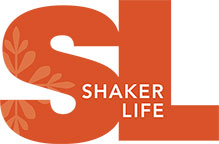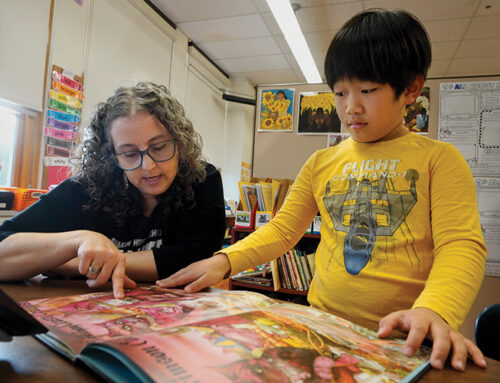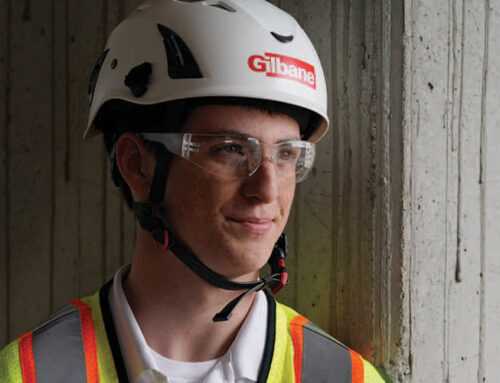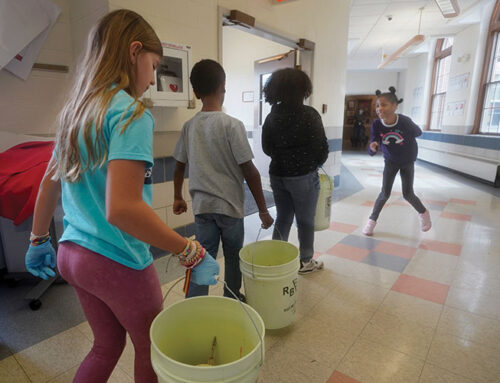The Shaker Heights Schools Innovative Center for Personalized Learning was once known as an alternative for students who didn’t “fit in.” Today, thanks to strong leadership and lessons learned, it’s where many students choose to be.
By Jennifer Kuhel

A meeting of Team Fortitude at Shaker Heights School’s Innovative Center for Personalized Learning. Photographs by Gus Chan.
Every Wednesday afternoon, a a small group of high school students from the District’s Innovative Center for Personalized Learning gathers to attend a special meeting called Team Fortitude. For most of last school year, they met via Zoom, joining the meeting one at a time, cameras and microphones on, waving hello and fl ashing smiles to a team of adult advisors who are there for one purpose: to connect with the students.
Each meeting starts with an ice breaker like “if you were stranded on a deserted island for a month, what three items would you want to have with you?” The ice breakers are innocuous enough, but they also put each student in the frame of mind to share, to engage, and, over time, to trust the adults with the often heavy discussions that follow.
“We wanted to bring together mentors and students to have a kind of intergenerational space where people can connect and bond and laugh and talk about real issues,” says Matt Simon, the Innovative Center’s coordinator. “Many of these students are kids who don’t tend to turn on their cameras in other spaces, but they turn them on in this space because they feel seen and valued. That alone is an important step in the IC getting closer to the kind of community that we’re trying to be.”
The Innovative Center, better known as the IC, is a program for Shaker Heights High School students who have found that the traditional high school environment doesn’t work for them academically, and, in some cases, socially. The IC offers blended learning (a mixture of online classes and in-person support) and personalized educational programming designed to meet students where they are and to help them fi nd their own pathway to success.
The IC, which opened in the lower level of the Stephanie Tubbs Jones Community Building in 2014, has for the most part functioned quietly in the shadow of Shaker Heights High School. But today, thanks to a combination of the strong leadership from Simon and Shaker Heights High School principal Eric Juli, seven years of lessons learned, and a pandemic that uncovered opportunities for improvement, the IC is making a name for itself as a space that’s defined by student success and a sense of belonging.
Beginnings
District Chief Academic Officer Marla Robinson remembers the day in 2013 when she and then-Superintendent Gregory C. Hutchings, Jr. visited North Coast Academy, an online learning center and alternative school located in Richmond Heights. At the time, Shaker Heights High School students who weren’t succeeding at the main campus were bused daily to North Coast, along with students from other nearby school districts. Robinson and Hutchings met up with a group of Shaker students during their visit to ask them about their experiences.

Nathaniel Reese greets students at the Wednesday session of Team Fortitude at the Shaker Heights Schools Innovative Center for Personalized Learning. Students meet with adult mentors to talk about issues they face at home and at school.
“These students felt dejected and pushed aside,” Robinson recalls. “They talked about feeling disconnected from the main campus. These were students who were already struggling with school and we were making it even harder for them to go to school.”
Robinson and Hutchings sat in silence the entire drive back to Shaker.
“It was so spirit shattering to see what we were doing to those kids,” she says. “We realized that it wasn’t that these kids decided they weren’t going to be successful – school was deciding that for them.”
So Hutchings and Robinson approached the Shaker Schools Foundation to create a plan for an alternative program created specifically for Shaker Heights High School students and located within the City. Within 24 hours, the Foundation raised $200,000 in verbal commitments to start the program.
Success Stories
The District’s initial plan for the IC was to implement the program in phases. The first phase was to open the IC’s doors to the approximately 50 students who had been attending North Coast Academy. The next phase was to increase participation in the IC by students who chose to take online courses because of scheduling conflicts or who wanted to complete additional courses online.
“We started from scratch,” says Robinson. “And implementation takes time to do it well.” Changes in leadership at both the High School and at the IC in recent years impacted consistency and the IC’s implementation plans. Then in 2019 the District hired Juli, who had significant experience working in non-traditional, project-based learning environments. A year later the District hired Simon, who had extensive experience overseeing innovative alternative high schools and is a self-described “kid who liked learning but didn’t like school.” The IC thus had the leadership and support to realize its original mission for any student who walked through its doors.
Simon wasted no time in engaging students and implementing efficiencies with online education providers that would directly improve student learning. “When I met with the IC staff at the beginning of 2020, we talked about our guiding principles – what we were trying to be. We wanted to know who our kids were, what we wanted for them, and how we could support them in getting there,” Simon says. “This wasn’t going to be just a space where kids hop on a computer and get their credits.”
Simon began by connecting with students and taking the time to understand how they learned as individuals. One of those students was Danielle Tall, a junior who was taking an online class and wasn’t learning from the videos offered by the instructor. She realized on her own that she learned better by reviewing the guided notes and referencing the video transcripts later. “I wasn’t watching the videos. I was teaching myself and getting A’s in the class,” she says.
As COVID-19 cases began to rise and social justice protests broke out across the country, Danielle, who has struggled with anxiety and depression, became anxious, and she wrote an email asking for extra class time to complete her work. Simon was on the email thread and reached out to her.
“He jumped right in and said that he completely understood how I felt. He said that he wanted to hear more about my learning style. All of a sudden, someone was paying attention to me, listening to me,” she says. Simon asked Danielle to join Team Fortitude and to apply to be on the Superintendent’s Student Advisory Council. She now participates in both.
“When I was alone, I felt like I was setting myself up for failure, but now, I feel like I’m being set up for success,” she says.
Danielle’s mother, Joi Taylor-Powell, is thrilled. “Mr. Simon homes in on each student’s individual needs, then he and the staff members support those needs. It’s really made a difference,” she says. “Danielle’s outlook has changed. She used to think that after high school, she might attend community college, which would have been fine. But now she’s looking at going to Howard University. When she realized what she was capable of, everything changed.”
“We wanted to bring together mentors and students to have a kind of intergenerational space where people can connect and bond and laugh and talk about real issues.”
Lori Thorrat’s son, Nathan Kocsis, a junior, has also found his recipe for success at the IC. Last spring, Thorrat noticed that Nathan was struggling when his classes shifted to online at the start of the pandemic. Nathan, who has been diagnosed with Attention Deficit Hyperactivity Disorder, was growing increasingly disengaged from school.
Thorrat reached out to Juli to see if there were any other options for her son. “I remember him asking me, ‘How flexible are you?’ I didn’t know what the IC was, but Mr. Juli suggested that I have a conversation with Mr. Simon.”
Simon shared his vision for the IC and for Nathan. “Then we brought Nathan into the conversation and it really seemed to appeal to him,” Thorrat says. “The fact that he could be online and be with people appealed to him. So we started with one class, then we moved to another, and now we’re taking three classes at the IC. He’s still taking his AP European History class, which he loves, at the High School. “He’s a really bright kid, but he struggles with some of the executive functioning skills that other children take for granted. Now, he doesn’t feel the pressure that he felt when he was put on the spot for not doing something that he genuinely may not have known how to do.”
Since Nathan started at the IC, Thorrat says that her son has been more optimistic about school and about his future. Last semester, he started working on a personal project that involved building a computer. “For Nathan to say that he likes to assemble things and to solve problems and that he’s interested in mechanics is the most down-to-earth and focused he’s ever been about his future,” Thorrat says.
During a recent chat with Thorrat, Simon told her that Nathan is a natural leader who collaborates well with other students who share similar struggles. “When you have a kid who’s struggled for so long, you don’t expect to hear good things,” she says. “It was something that was so gratifying to hear. I feel like the IC is absolutely the right thing for Nathan right now.”
The Future of the IC
During the 2020-21 school year, IC enrollment more than doubled to its current enrollment of 77 students. Simon says the reason for the growth is two-fold: pandemic-related learning challenges and the program’s growing positive reputation, thanks in no small part to High School principal Eric Juli.

Innovative Center coordinator Matt Simon works with student Henry Barefoot.
“Some parents came to me because traditional school in the pandemic wasn’t working for their child and they wanted to know if there were other options,” Juli says. “I knew that Matt Simon and I shared a mindset to imagine school differently.”
Juli found that families who didn’t know about the IC or who previously didn’t believe the IC was a good fit for their students began to consider it as an option. “We’ve shifted the narrative to be that the IC is a place for creatively meeting the needs of a student, no matter what those needs are. And that’s an entirely different framing of the IC.”
While the growing enrollment is indicative of the IC’s strengths, Juli says that the program may shine a light on what can be improved at the main campus of the High School. “We have some students who are at the IC because they may be on the Autism spectrum, or because they have struggled for any number of reasons,” he explains. “So, for example, if there’s an increase in students on the Autism spectrum who want to go to the IC, then that would indicate that we need to make changes at the main campus to support those students.”
In the meantime, Simon will continue doing what he does best: meet students’ learning styles creatively and show them that they belong.
“We want to be the school where we learn who our students are and build a system around them. And then we learn more about their strengths and interests and figure out a way to use them,” Simon says. “If we function as a strengths-based and interest-based school, then students will feel like we’re meeting their needs. And that’s very powerful.”
Learn more about the Innovative Center for Personalized Learning.



